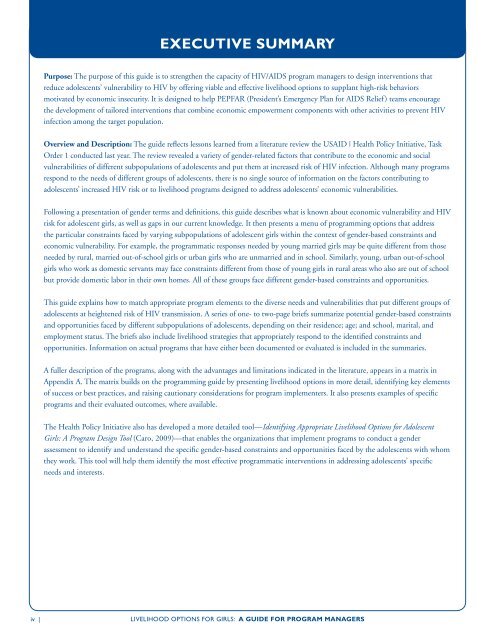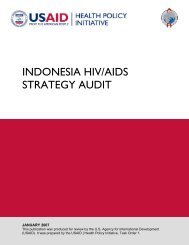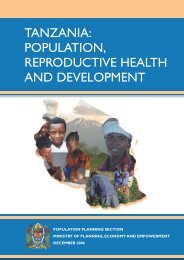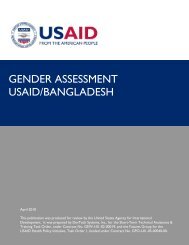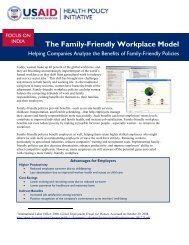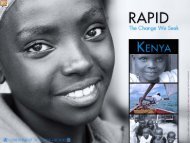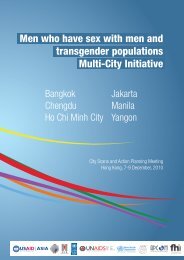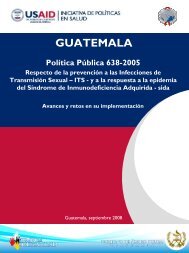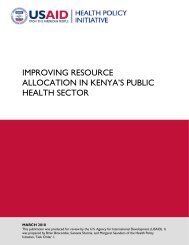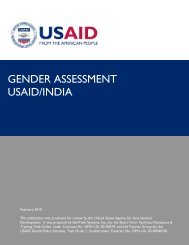LIVELIHOOD OPTIONS FOR GIRLS: - Health Policy Initiative
LIVELIHOOD OPTIONS FOR GIRLS: - Health Policy Initiative
LIVELIHOOD OPTIONS FOR GIRLS: - Health Policy Initiative
- No tags were found...
Create successful ePaper yourself
Turn your PDF publications into a flip-book with our unique Google optimized e-Paper software.
EXECUTIVE SUMMARYPurpose: The purpose of this guide is to strengthen the capacity of HIV/AIDS program managers to design interventions thatreduce adolescents’ vulnerability to HIV by offering viable and effective livelihood options to supplant high-risk behaviorsmotivated by economic insecurity. It is designed to help PEPFAR (President’s Emergency Plan for AIDS Relief) teams encouragethe development of tailored interventions that combine economic empowerment components with other activities to prevent HIVinfection among the target population.Overview and Description: The guide reflects lessons learned from a literature review the USAID | <strong>Health</strong> <strong>Policy</strong> <strong>Initiative</strong>, TaskOrder 1 conducted last year. The review revealed a variety of gender-related factors that contribute to the economic and socialvulnerabilities of different subpopulations of adolescents and put them at increased risk of HIV infection. Although many programsrespond to the needs of different groups of adolescents, there is no single source of information on the factors contributing toadolescents’ increased HIV risk or to livelihood programs designed to address adolescents’ economic vulnerabilities.Following a presentation of gender terms and definitions, this guide describes what is known about economic vulnerability and HIVrisk for adolescent girls, as well as gaps in our current knowledge. It then presents a menu of programming options that addressthe particular constraints faced by varying subpopulations of adolescent girls within the context of gender-based constraints andeconomic vulnerability. For example, the programmatic responses needed by young married girls may be quite different from thoseneeded by rural, married out-of-school girls or urban girls who are unmarried and in school. Similarly, young, urban out-of-schoolgirls who work as domestic servants may face constraints different from those of young girls in rural areas who also are out of schoolbut provide domestic labor in their own homes. All of these groups face different gender-based constraints and opportunities.This guide explains how to match appropriate program elements to the diverse needs and vulnerabilities that put different groups ofadolescents at heightened risk of HIV transmission. A series of one- to two-page briefs summarize potential gender-based constraintsand opportunities faced by different subpopulations of adolescents, depending on their residence; age; and school, marital, andemployment status. The briefs also include livelihood strategies that appropriately respond to the identified constraints andopportunities. Information on actual programs that have either been documented or evaluated is included in the summaries.A fuller description of the programs, along with the advantages and limitations indicated in the literature, appears in a matrix inAppendix A. The matrix builds on the programming guide by presenting livelihood options in more detail, identifying key elementsof success or best practices, and raising cautionary considerations for program implementers. It also presents examples of specificprograms and their evaluated outcomes, where available.The <strong>Health</strong> <strong>Policy</strong> <strong>Initiative</strong> also has developed a more detailed tool—Identifying Appropriate Livelihood Options for AdolescentGirls: A Program Design Tool (Caro, 2009)—that enables the organizations that implement programs to conduct a genderassessment to identify and understand the specific gender-based constraints and opportunities faced by the adolescents with whomthey work. This tool will help them identify the most effective programmatic interventions in addressing adolescents’ specificneeds and interests.iv |<strong>LIVELIHOOD</strong> <strong>OPTIONS</strong> <strong>FOR</strong> <strong>GIRLS</strong>: A GUIDE <strong>FOR</strong> PROGRAM MANAGERS


